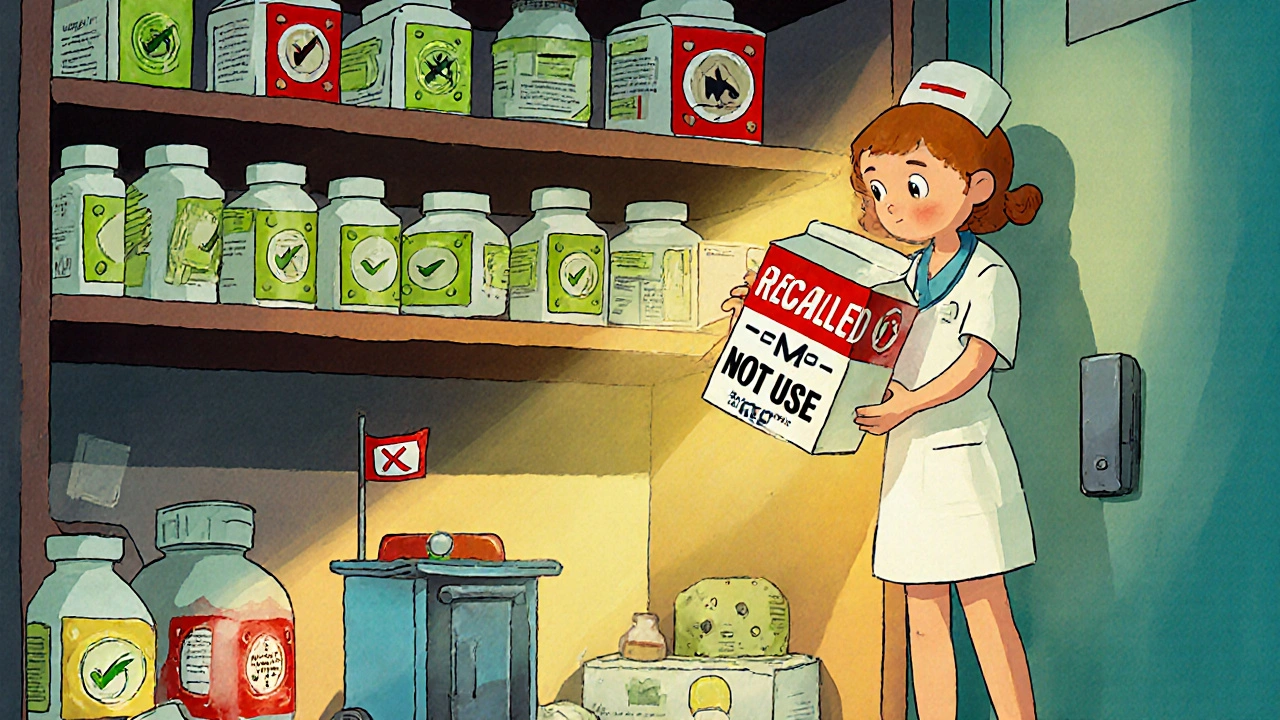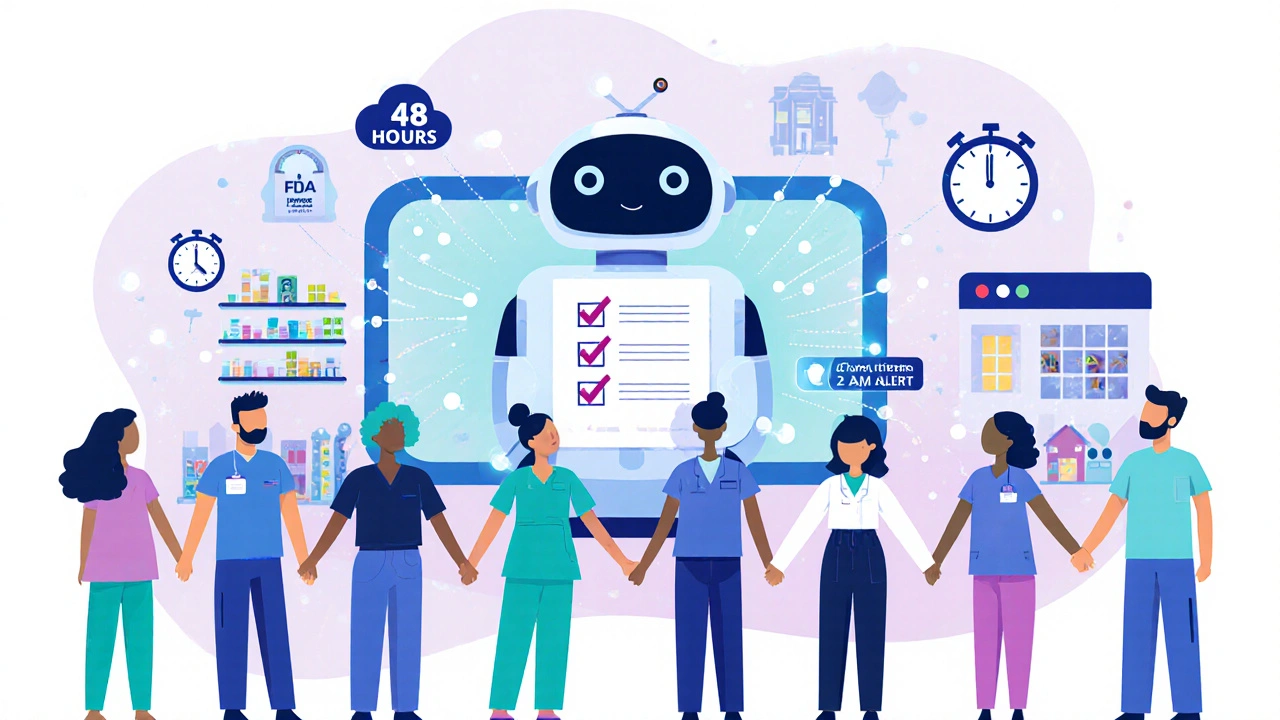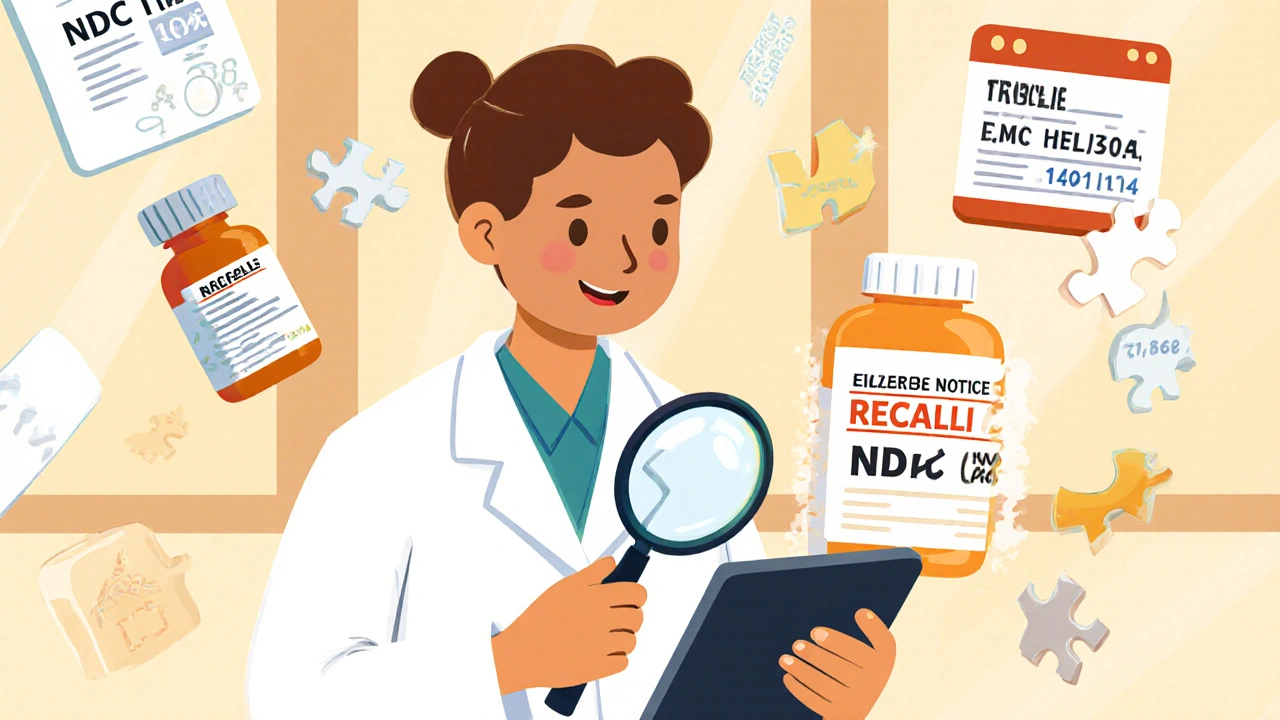When a drug recall happens, time isn’t just money-it’s lives. A single contaminated batch of blood pressure medication, mislabeled insulin, or improperly stored antibiotic can cause serious harm or even death. The medication recall verification process isn’t optional. It’s a legal and ethical requirement for every pharmacy, hospital, and clinic. But how do you actually find out if you have the bad batch? And what do you do once you do?
Understand the Recall Classes
Not all recalls are created equal. The FDA classifies them into three levels based on how dangerous the product is. Class I recalls are the most urgent. These involve products that could cause serious injury or death. Think contaminated IV fluids, pills with wrong dosages, or antibiotics that lost potency. Class II recalls are less severe but still risky-maybe the medication has a labeling error or minor contamination. Class III are the least dangerous, often involving packaging issues that don’t affect safety. Knowing the class tells you how fast you need to act. For Class I, you have 48 hours to verify and remove every affected lot. No exceptions.Don’t Rely on Just One Source
Many people think they’ll get a recall notice in the mail or via email from the manufacturer. That’s a mistake. The FDA’s MedWatch portal is free, but you have to check it daily. Manufacturers don’t always notify everyone. A 2023 study by ISMP found that 37% of recalls were never communicated directly to the facility. You need multiple sources. Subscribe to First Databank’s Recall Center. Sign up for alerts from Grayson’s RecallTrac. Check the FDA’s website every morning. Even if your pharmacy management system pushes alerts, cross-check with the FDA’s official list. If you’re waiting for one email to tell you what to do, you’re already behind.Match the Exact Product Details
Lot numbers aren’t suggestions-they’re exact identifiers. You need to match four things: the National Drug Code (NDC), the lot number, the expiration date, and the package size. Miss one, and you might leave a dangerous product on the shelf. The FDA’s 2022 audit found that 68% of facilities failed to verify all four. A common mistake? Assuming that if the NDC matches, the lot is fine. But two different lots can have the same NDC. One might be clean. The other might be contaminated. Always check the lot number on the bottle against the recall notice. And don’t forget emergency kits. Those are often overlooked. The FDA’s audit showed that 41% of recall deficiencies involved unopened emergency supplies stored in closets or crash carts.Remove the Product Immediately
Once you confirm you have the affected lot, remove it from every area-patient rooms, nursing stations, storage closets, even the fridge in the break room. Don’t wait until tomorrow. Don’t wait until your shift ends. Within 24 hours, that product must be quarantined and labeled as recalled. If it’s in a patient’s room, notify the nurse and replace it immediately. If it’s in your inventory, lock it up and mark it clearly. Use a red tag. Write “RECALLED - DO NOT USE” on the box. Don’t assume someone else will handle it. Assign one person on your team to be the recall point person. This isn’t a group task. It’s a single-responsibility job.
Find Alternatives Fast
You can’t just pull the drug and leave patients without treatment. You need a backup plan. For common medications like metformin or lisinopril, most pharmacies have alternate brands or generic equivalents. But for specialty drugs-like biologics for rheumatoid arthritis or rare cancer treatments-this gets harder. Start contacting your suppliers the moment you confirm the recall. Don’t wait for the manufacturer to suggest alternatives. Use your pharmacy’s formulary list. Check with your medical director. If you’re in a rural clinic with limited options, reach out to nearby hospitals. Some have surplus stock they can loan. The key is speed. The longer patients go without their meds, the higher the risk of complications.Document Everything
Paperwork isn’t bureaucracy-it’s your legal protection. The Joint Commission requires you to document every step: when you received the notice, which lots you found, when you removed them, who was notified, and how you contacted affected patients. You need exact dates, quantities, and lot numbers. If you don’t document it, the regulators assume you didn’t do it. And if you’re audited and can’t prove you acted, fines can hit $84,350 per violation. Use a standardized checklist. The FDA’s 7-point verification form is publicly available. Fill it out in real time. Don’t try to recreate it later. If you’re using an automated system, make sure it logs every action with a timestamp and user ID. If you’re doing it manually, use a printed form and have two staff members sign off.Automated Systems Save Time-and Lives
Manual verification is slow and error-prone. A 2022 ASHP study found that manual processes took an average of 4.7 hours per recall with an 18.3% error rate. That means nearly one in five times, someone missed a recalled lot. Automated systems like TruMed’s AccuSite or Navitus’ Recall Management Platform cut that time to under 1.2 hours and reduce errors to just 2.1%. These systems connect directly to your pharmacy inventory. When a recall comes in, they auto-match NDCs and lot numbers. They flag the products on your shelves. They even alert staff during dispensing. But they’re not perfect. They require integration with your existing software, which can be tricky in older clinics. If you’re a small independent pharmacy, you might not need a full system. But you still need a digital tool-like a shared Google Sheet with real-time updates-that lets your team see what’s been recalled and what’s been removed.
Train Your Team and Create a Playbook
You can’t rely on one person knowing what to do. Everyone-from the pharmacist to the pharmacy tech to the front desk clerk-needs to know the drill. Hold a 2-hour training session at least once a year. Use real recall examples. Walk through a mock scenario. Practice calling patients. Practice removing products. Create a “recall playbook.” This is a one-page document that answers: Who gets the alert? Who removes the product? Who contacts patients? Who documents it? Who calls the supplier? Eighty-six percent of top-performing facilities have one. If you don’t, you’re flying blind when the next recall hits.Watch for the Hidden Risks
The biggest danger isn’t the recall itself-it’s what happens after. False positives waste time. A system might flag a product that’s not actually affected. That’s happened in 63% of hospitals, according to a Pharmacy Times survey. Each false alarm wastes 2.7 hours. That’s hours you could’ve spent training, restocking, or helping patients. Also, don’t ignore after-hours recalls. Two out of three recalls happen outside business hours. You need an on-call protocol. Someone must be reachable at 2 a.m. if a Class I recall comes in. And watch out for inconsistent lot numbering. The FDA found that 47% of recalls involve confusing or mismatched lot formats. A manufacturer might use “LOT123” while your system expects “123-ABC.” Build a cross-reference guide for your team.What Happens If You Don’t Act?
Ignoring a recall isn’t just risky-it’s illegal. The FDA can shut down your facility. Your malpractice insurance might deny a claim if you used a recalled drug. Patients can sue. And the damage to your reputation? That’s permanent. In 2023, a small clinic in Ohio lost its license after failing to remove a recalled blood thinner. One patient had a stroke. The clinic had received the notice. They just didn’t act. You can’t afford that mistake. Compliance isn’t about avoiding fines. It’s about protecting the person who trusts you with their health.What’s Next?
The system is getting smarter. By 2026, most recalls will be verified through integrated supply chain platforms that use AI to match lots automatically. The FDA is already testing AI tools that predict which batches are likely to fail based on manufacturing data. Blockchain trials with Pfizer and Walgreens have cut verification time to just 17 minutes. But until then, you’re still responsible. The tools help-but you’re still the one who must check, remove, document, and act. Don’t wait for the next recall to start preparing. Start today. Update your playbook. Train your team. Check your inventory. Because when the next alert comes, you won’t have time to learn how to respond.How do I know if my pharmacy has a recalled medication?
Check multiple sources: the FDA’s MedWatch portal, your pharmacy management system alerts, and subscription services like First Databank or Grayson’s RecallTrac. Then cross-reference the recall notice with your inventory using the exact National Drug Code (NDC), lot number, expiration date, and package size. Never rely on just one source.
What should I do if I find a recalled drug in my inventory?
Immediately remove it from all areas-patient rooms, storage, emergency kits. Quarantine it with a clear “RECALLED - DO NOT USE” label. Notify your recall team, document the removal with lot numbers and dates, and contact your supplier for replacement options. For Class I recalls, you must complete this within 48 hours.
Are automated recall systems worth the cost?
For hospitals and large pharmacies, yes. Automated systems like TruMed or Navitus reduce verification time by over 70% and cut errors from 18% to under 3%. For small clinics, a simple digital checklist or shared spreadsheet may be enough. The key is consistency-not the price tag. Manual processes are riskier and more time-consuming in the long run.
Can I just wait for the manufacturer to tell me about a recall?
No. ISMP analysis shows 37% of recalls are never directly notified to facilities. Manufacturers may miss you, or their notice may be delayed. Always verify recalls independently using FDA sources and subscription services. Proactive checking is the only safe approach.
What are the consequences of missing a recall?
You could face FDA fines up to $84,350 per violation, lose your license, or be sued if a patient is harmed. Insurance may deny coverage. Your reputation can be destroyed. Even one missed lot can lead to serious injury or death. Verification isn’t paperwork-it’s patient safety.
How often should I train my staff on recall procedures?
At least once a year, as required by the Joint Commission. But for best results, run a quick 15-minute refresher every quarter. Use real recall examples from the past year. Make sure everyone-from pharmacists to technicians-knows their role in the recall playbook.
Do I need to notify patients who received the recalled drug?
Yes-for Class I and often Class II recalls. You must contact all direct patients who received the affected lot. Document who you contacted, how, and when. Use your pharmacy’s patient database. If you don’t have contact info, work with your medical director to find alternatives. Patient safety requires direct communication.
What’s the most common mistake in recall verification?
Failing to check emergency kits and unopened stock. The FDA found that 41% of recall deficiencies involved products stored in crash carts, backup cabinets, or on shelves that weren’t part of the main inventory. Always include every possible location where the drug might be stored.



Comments (9)
Neoma Geoghegan
Class I recall? Drop everything. 48 hours isn't a suggestion, it's a lifeline. Miss it and you're gambling with lives.
Check FDA. Cross-reference NDC + lot + expiry. No excuses.
Bartholemy Tuite
Man I seen so many clinics just wait for that damn email like it's a birthday card. Nah. The FDA ain't texting you. You gotta be out there scraping every portal, every alert, every damn database. First Databank, Grayson, MedWatch - all of it. And don't even get me started on emergency kits. I found a recalled insulin in a crash cart last year. Still gives me chills. That shit ain't stored in the main fridge. It's tucked behind the defibrillator like a secret. You think you're safe? You're not. You're just lazy.
Automated systems? Worth every penny if you're big. Small shop? Google Sheet with color coding. Red = danger. Green = clean. Done. No more guessing.
Sam Jepsen
This is the kind of post that saves lives. Seriously. I run a rural pharmacy and we use a shared Google Sheet synced to our phones. When a recall drops, we tag the lot, update location, and ping the team. No one misses it. We also do a 10-minute huddle every Monday - real quick, just walk through last week’s recalls. Keeps everyone sharp. Training isn’t a box to check. It’s your armor.
And yeah - emergency kits. Always check them. Always.
Yvonne Franklin
Lot number mismatch is the silent killer. NDC alone means nothing. Two lots can share the same NDC but one is tainted. I’ve seen it. You check the bottle. You check the label. You check the system. You don’t assume. You verify. And document. Every single step. No shortcuts. Not even for the 3am recall that comes in during your day off.
Also - patients. If it’s Class I, you call them. Not email. Not text. Call. They need to hear it from you. That’s the human part they forget in all the tech talk.
Miruna Alexandru
It’s fascinating how the entire system is built on the assumption that humans are rational actors with infinite attention spans. Yet we ask a pharmacy tech to cross-reference NDCs at 2 a.m. after a 12-hour shift. The real failure isn’t the recall - it’s the expectation that manual labor can scale with precision in a broken system. Automation isn’t a luxury. It’s a moral imperative. And yet, we still treat compliance like a paperwork chore instead of a neurobiological safeguard for human vulnerability.
Also, your ‘playbook’ is just a euphemism for institutionalized trauma response. You’re not preparing for recalls - you’re preparing for the inevitable collapse of a system that outsources safety to overworked people.
Robin Johnson
Y’all are missing the biggest point: false positives. Every time a system flags a clean lot, you lose time. You lose trust. You lose focus. I’ve seen teams get so burnt out from false alarms they start ignoring real ones. The solution? Don’t just use the system - tune it. Build a cross-reference guide for weird lot formats. Train people to spot the red flags. And never, ever trust an alert without verifying the source.
Also - 41% of missed recalls are in emergency kits. That’s not a typo. That’s a death sentence waiting to happen. Check the closets. Check the drawers. Check the damn crash cart. Again. And again.
Latonya Elarms-Radford
Let’s be real - this whole system is a performance art piece for regulators. We’re told to ‘verify’ and ‘document’ and ‘train’ like these are holy rituals, but nobody asks why the system is designed to fail. Why do we rely on overworked nurses to spot a mislabeled lot at 3 a.m.? Why are we still using paper checklists in 2025? Why is blockchain being tested by Pfizer but not mandated by the FDA? This isn’t about safety - it’s about control. The real recall isn’t the drug. It’s the system that makes us beg for permission to save lives.
And yet… we still show up. We still check the lot numbers. We still call the patients. Because we’re not here for the paperwork. We’re here for the people. Even when the system forgets them.
Ravi Kumar Gupta
In India, we don’t have fancy systems. We have WhatsApp groups. One nurse sees a recall alert, screenshots it, drops it in the group - ‘Lot 234-ABC, recall Class I, check all insulin vials’. Someone checks the fridge. Someone calls the doctor. Someone updates the clipboard. We don’t need AI. We need community.
But yeah - emergency kits. Always check the emergency kits. I once found a recalled antibiotic in a delivery bag behind the pharmacy counter. No one even knew it was there. That’s the problem. We forget the hidden places. The forgotten corners. The stuff we don’t see because it’s not on the inventory list.
Train your team. Talk to them. Listen to them. They’ll tell you where the real risks are.
Rahul Kanakarajan
Wow. So much effort for something that should be automatic. You’re telling me a small clinic in Nebraska has to manually cross-check NDCs and lot numbers while also calling patients and documenting everything? And if they miss one? They get fined $84k? That’s not compliance. That’s institutional bullying.
Meanwhile, big pharma ships out millions of doses with zero accountability. They don’t get audited. They don’t get fined. They just issue a press release and move on. But the pharmacy? The nurse? The tech? They’re the ones holding the bag.
So yeah - check your kits. Use your spreadsheet. Train your team. But don’t fool yourself. This system is rigged. You’re just the one who has to clean up the mess.